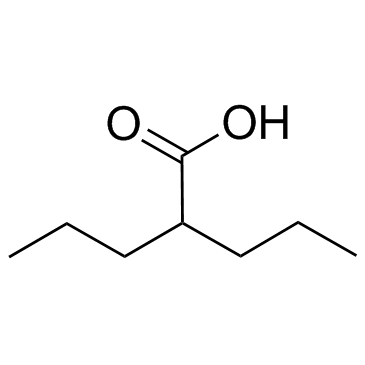丙戊酸

丙戊酸结构式

|
常用名 | 丙戊酸 | 英文名 | Valproic acid |
|---|---|---|---|---|
| CAS号 | 99-66-1 | 分子量 | 144.211 | |
| 密度 | 0.9±0.1 g/cm3 | 沸点 | 220.0±0.0 °C at 760 mmHg | |
| 分子式 | C8H16O2 | 熔点 | 120 - 130ºC | |
| MSDS | 中文版 美版 | 闪点 | 111.1±0.0 °C | |
| 符号 |


GHS07, GHS08 |
信号词 | Danger |
|
Synergism of arsenic trioxide and MG132 in Raji cells attained by targeting BNIP3, autophagy, and mitochondria with low doses of valproic acid and vincristine.
Eur. J. Cancer 50(18) , 3243-61, (2014) We previously demonstrated that arsenic trioxide (ATO) and proteasome inhibitor MG132 synergistically induced cell death in promonocytic leukaemia cell line U937 but were antagonistic in Burkitt's lymphoma cell line Raji. Here we explore the role of autophagy... |
|
|
Combined histone deacetylase inhibition and tamoxifen induces apoptosis in tamoxifen-resistant breast cancer models, by reversing Bcl-2 overexpression.
Breast Cancer Res. 17 , 26, (2015) The emergence of hormone therapy resistance, despite continued expression of the estrogen receptor (ER), is a major challenge to curing breast cancer. Recent clinical studies suggest that epigenetic modulation by histone deacetylase (HDAC) inhibitors reverses... |
|
|
HD iPSC-derived neural progenitors accumulate in culture and are susceptible to BDNF withdrawal due to glutamate toxicity.
Hum. Mol. Genet. 24 , 3257-71, (2015) Huntington's disease (HD) is a fatal neurodegenerative disease, caused by expansion of polyglutamine repeats in the Huntingtin gene, with longer expansions leading to earlier ages of onset. The HD iPSC Consortium has recently reported a new in vitro model of ... |
|
|
Cheminformatics analysis of assertions mined from literature that describe drug-induced liver injury in different species.
Chem. Res. Toxicol. 23 , 171-83, (2010) Drug-induced liver injury is one of the main causes of drug attrition. The ability to predict the liver effects of drug candidates from their chemical structures is critical to help guide experimental drug discovery projects toward safer medicines. In this st... |
|
|
Translating clinical findings into knowledge in drug safety evaluation--drug induced liver injury prediction system (DILIps).
J. Sci. Ind. Res. 65(10) , 808, (2006) Drug-induced liver injury (DILI) is a significant concern in drug development due to the poor concordance between preclinical and clinical findings of liver toxicity. We hypothesized that the DILI types (hepatotoxic side effects) seen in the clinic can be tra... |
|
|
The Japanese toxicogenomics project: application of toxicogenomics.
Mol. Nutr. Food. Res. 54 , 218-27, (2010) Biotechnology advances have provided novel methods for the risk assessment of chemicals. The application of microarray technologies to toxicology, known as toxicogenomics, is becoming an accepted approach for identifying chemicals with potential safety proble... |
|
|
Developing structure-activity relationships for the prediction of hepatotoxicity.
Chem. Res. Toxicol. 23 , 1215-22, (2010) Drug-induced liver injury is a major issue of concern and has led to the withdrawal of a significant number of marketed drugs. An understanding of structure-activity relationships (SARs) of chemicals can make a significant contribution to the identification o... |
|
|
A predictive ligand-based Bayesian model for human drug-induced liver injury.
Drug Metab. Dispos. 38 , 2302-8, (2010) Drug-induced liver injury (DILI) is one of the most important reasons for drug development failure at both preapproval and postapproval stages. There has been increased interest in developing predictive in vivo, in vitro, and in silico models to identify comp... |
|
|
Air to lung partition coefficients for volatile organic compounds and blood to lung partition coefficients for volatile organic compounds and drugs.
Eur. J. Med. Chem. 43 , 478-85, (2008) Values of in vitro gas to lung partition coefficients, K(lung), of VOCs have been collected from the literature. For 44 VOCs, application of the Abraham solvation equation to log K(lung) yielded a correlation with R(2)=0.968 and S.D.=0.25 log units. Combinati... |
|
|
Pathological roles of the VEGF/SphK pathway in Niemann-Pick type C neurons.
Nat. Commun. 5 , 5514, (2014) Sphingosine is a major storage compound in Niemann-Pick type C disease (NP-C), although the pathological role(s) of this accumulation have not been fully characterized. Here we found that sphingosine kinase (SphK) activity is reduced in NP-C patient fibroblas... |